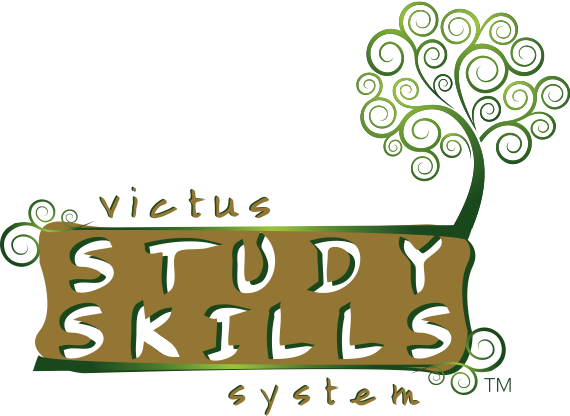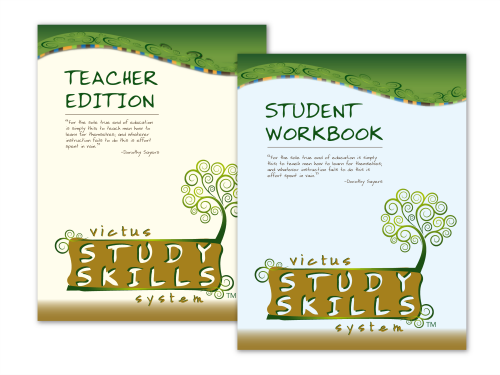
When Victus Study Skills System was
offered as a product to review, I was excited about being able to use a system
to ensure that my son, who will be taking the SAT in May and dual enrolling in
the local community college in the fall, had effective study skills. We
received the student
workbook and the teacher edition. I am glad we were able to review this
product as we both learned quite a bit about good study habits, note taking,
and test taking. Much of the information was new to my son, so this review
couldn’t have been better timed.

The teacher edition opens
by explaining that the Victus Study Skills System is a way of life. The course
aim is then described in both the teacher edition and the student workbook.
This aim has four components. In brief, they are:
- Zeal with knowledge bears fruit.
- Results come from the process.
- Any system must have a purpose.
- An effective study system has the greatest likelihood of aiding in success.
The ten lessons are broken down into three foundational cornerstones: Where am I now? Where do I want to be? and How do I get there? Each of the lessons is extremely interactive. In order for my son to get an idea of where he is now, he took a study habits checklist to see what he does "never," "sometimes," and "often." He found out what his learning strength is. It occurred to me after going through the Victus Study Skills System that he never knew he is an auditory learner. It all made sense to him then that he reads certain things out loud and tries to work out his math problems by speaking them. Not only did he learn his strength, he also learned what sorts of things he should do to capitalize on that strength. For example, auditory learners should read aloud whenever they are able to and create some sort of mnemonic like a poem or a song to help them remember information.
The second section—Where do I want to be?—shares the stories of some famous people and the struggles they went through to achieve their goals. I appreciated this. It is always good for young people to gain some perspective so that they are not discouraged when things are difficult. Difficulties can be overcome if they persevere. An important part of this second section is learning how to set goals and actually setting some for the fall, spring, and summer. Charts are provided and are broken down into goal, objective, and action plan headings and are further broken down into financial, intellectual, community service, spiritual/emotional, physical fitness/health, and more. My son felt this was probably the most difficult part of the system. Setting goals that are measurable, realistic, etc., are sometimes hard to do, especially if you haven't spent much time thinking about them. As his life changes, goal setting may become easier. We'll have to readdress this part of the system.
The third cornerstone—How do I get there?—is the most instructional unit. The bulk of the study skills are taught here. Fill-in-the-blank worksheets are provided so the student can fill things in as the teacher reads the items from the teacher edition. This way they are hearing the words, seeing the words, and actually writing the words. The workbook is full of creative images, used to break up what could otherwise be a dull study. All of the answers are provided in the teacher edition for the worksheets, except for the final test. The fact that the final test answers weren't available was probably the most frustrating thing about the whole study skills system. It meant that I had to search for the answers myself. This was not the best thing for my already busy day.
Some of the topics in this third unit are time management, organization, and preparing an adequate study environment. Another lesson, "PQRST," explains the process of studying. It all seems so simple. When did we forget these basic elements of proper study habits? I went through this program with my high schooler, but it dawned on me today that I should use it with my sixth grader for her history. There is a lot of information to remember for the tests, and although she does well on most of them, I'd love for her to remember what she has learned beyond the test. The "Be an Active Listener" and "Note Taking Hints" lessons provide many great tips like being brief when taking notes by using abbreviations, not crossing t's or dotting i's, and going home and rewriting class notes. Since we homeschool, some of this information seemed irrelevant for life at this moment, but I know as my son begins dual enrollment in the fall he will need to remember what he has learned through this program. The final lesson in this unit talks about test preparation and strategies for taking the test. Despite the fact that we completed the Victus Study Skills System, my son forgot to apply what he learned when taking his end-of-the-year examination. He didn't read through the problems to do the easy ones first. He didn't look for cues and ended up leaving many math problems unfinished.
In order to get the most benefit from this program, you have to apply the skills taught in this program to this program. The skills must be reviewed again and again until they are second nature. I am hoping to have enough practice with my son with other tests and new chapters in his regular school work before he takes his first SAT in May. It would be wonderful if he could enter that exam with the skills necessary to do well on it.
The appendices contain useful information about organization, time management, and mnemonic devices. PQRST flashcards are available to help students remember the action that should be taken for each step, along with a grade log.
This course can be taught to students of all ages, but it is most appropriate for those in 5th through 12th grade. Younger students will require more more instruction. The teacher edition is $40.00, and the student workbook is $20. Additional products are available, including a student DIY workbook for those times when a teacher isn't available, a PowerPoint presentation, a training video, and a booklet for adults to implement this system in their own lives.
The second section—Where do I want to be?—shares the stories of some famous people and the struggles they went through to achieve their goals. I appreciated this. It is always good for young people to gain some perspective so that they are not discouraged when things are difficult. Difficulties can be overcome if they persevere. An important part of this second section is learning how to set goals and actually setting some for the fall, spring, and summer. Charts are provided and are broken down into goal, objective, and action plan headings and are further broken down into financial, intellectual, community service, spiritual/emotional, physical fitness/health, and more. My son felt this was probably the most difficult part of the system. Setting goals that are measurable, realistic, etc., are sometimes hard to do, especially if you haven't spent much time thinking about them. As his life changes, goal setting may become easier. We'll have to readdress this part of the system.
The third cornerstone—How do I get there?—is the most instructional unit. The bulk of the study skills are taught here. Fill-in-the-blank worksheets are provided so the student can fill things in as the teacher reads the items from the teacher edition. This way they are hearing the words, seeing the words, and actually writing the words. The workbook is full of creative images, used to break up what could otherwise be a dull study. All of the answers are provided in the teacher edition for the worksheets, except for the final test. The fact that the final test answers weren't available was probably the most frustrating thing about the whole study skills system. It meant that I had to search for the answers myself. This was not the best thing for my already busy day.
Some of the topics in this third unit are time management, organization, and preparing an adequate study environment. Another lesson, "PQRST," explains the process of studying. It all seems so simple. When did we forget these basic elements of proper study habits? I went through this program with my high schooler, but it dawned on me today that I should use it with my sixth grader for her history. There is a lot of information to remember for the tests, and although she does well on most of them, I'd love for her to remember what she has learned beyond the test. The "Be an Active Listener" and "Note Taking Hints" lessons provide many great tips like being brief when taking notes by using abbreviations, not crossing t's or dotting i's, and going home and rewriting class notes. Since we homeschool, some of this information seemed irrelevant for life at this moment, but I know as my son begins dual enrollment in the fall he will need to remember what he has learned through this program. The final lesson in this unit talks about test preparation and strategies for taking the test. Despite the fact that we completed the Victus Study Skills System, my son forgot to apply what he learned when taking his end-of-the-year examination. He didn't read through the problems to do the easy ones first. He didn't look for cues and ended up leaving many math problems unfinished.
In order to get the most benefit from this program, you have to apply the skills taught in this program to this program. The skills must be reviewed again and again until they are second nature. I am hoping to have enough practice with my son with other tests and new chapters in his regular school work before he takes his first SAT in May. It would be wonderful if he could enter that exam with the skills necessary to do well on it.
The appendices contain useful information about organization, time management, and mnemonic devices. PQRST flashcards are available to help students remember the action that should be taken for each step, along with a grade log.
This course can be taught to students of all ages, but it is most appropriate for those in 5th through 12th grade. Younger students will require more more instruction. The teacher edition is $40.00, and the student workbook is $20. Additional products are available, including a student DIY workbook for those times when a teacher isn't available, a PowerPoint presentation, a training video, and a booklet for adults to implement this system in their own lives.
and Twitter @VictusStudy.

